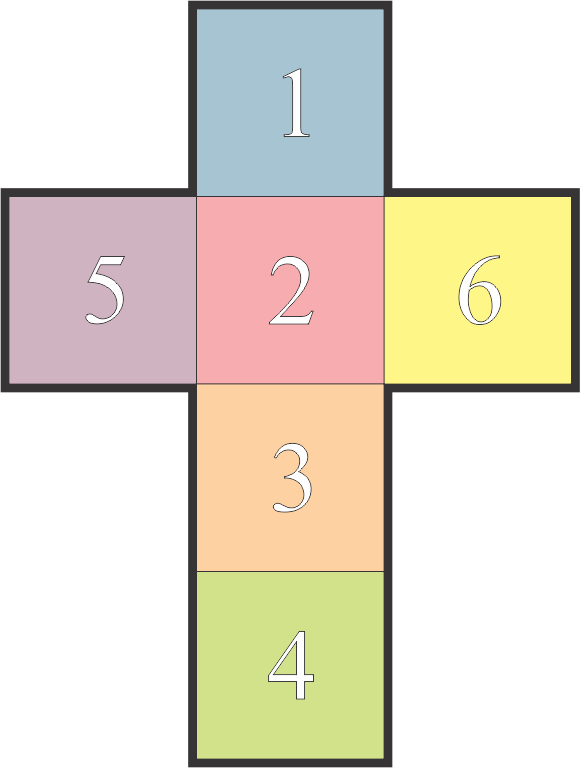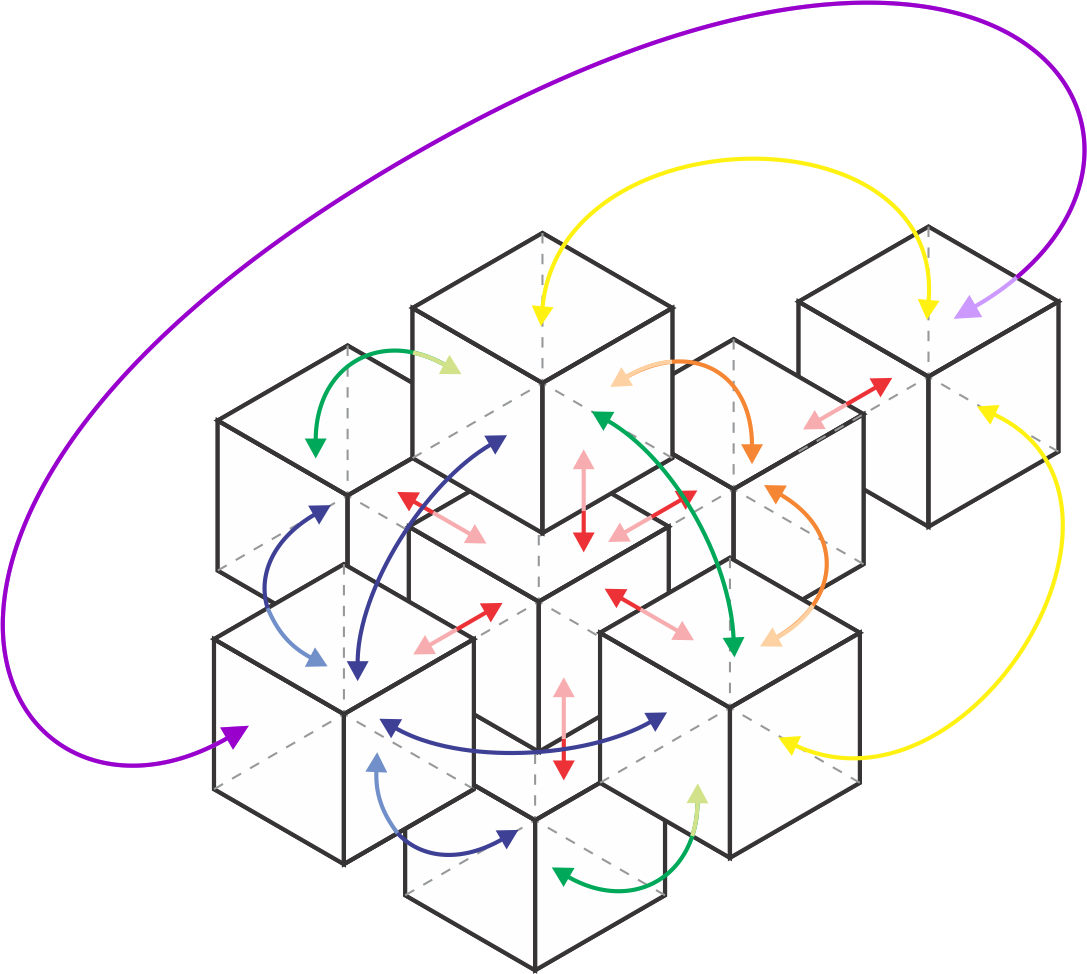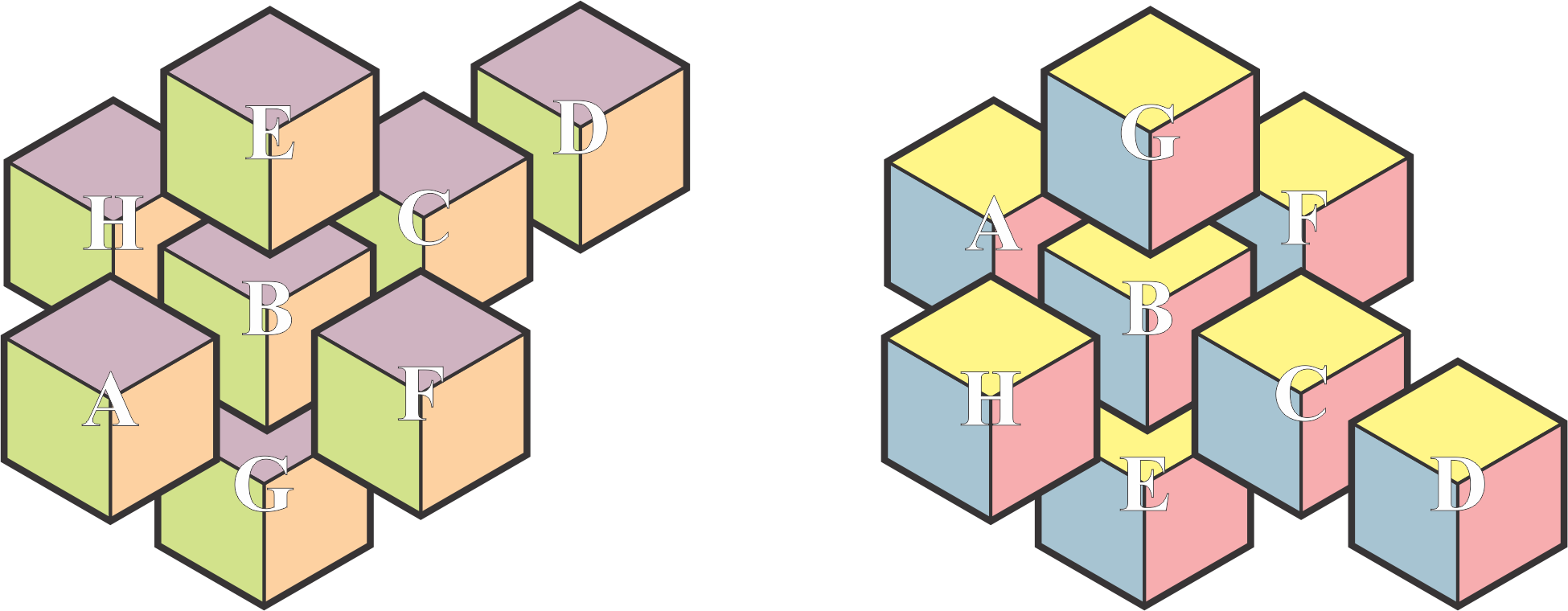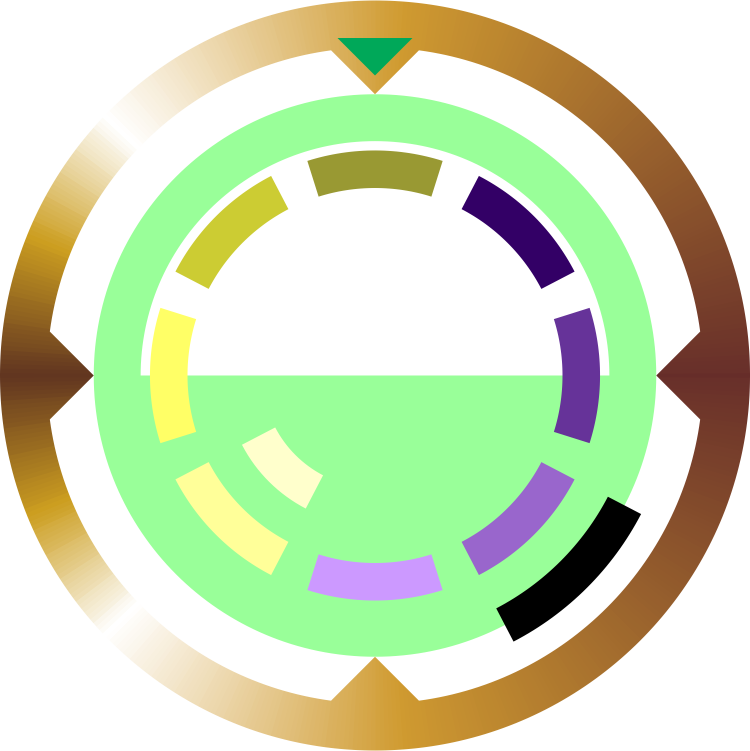The Geometries of the Manifold Sky - A History
The Cradle of Humanity
In the prehistory of the Manifold Sky, mankind was not aware that the world was unusual - save, of course, for the fact that the entire known world existed on the inside surface of a Cube, with gravity pulling people to the faces, the landscape into ridges along the edges, and the ridges into mountain peaks along the corners. The "sun" which occupied the center of this home cube remained an unexplained source of light and heat; the fissures which gouged deeply into the faces of the cubic world - so deep were they that everything beyond faded into dust and mist - remained unexplored. The faces of the cube, interchangeable as they were, were simply numbered, with the "first" face being the home of the first known tribes of humanity. Fig. 1 - An unfolded cube, and the official numerical face designation scheme used by the Navigator's Guild.Celestial Realms
The early humans wondered from whence they came if the world was closed, eventually coming to the conclusion that they must've come from beyond the fissures, from the mist-enshrouded realms of the ancient gods and goddesses which had formed them. Perhaps, the humans mused, they had been imprisoned here for some slight against their creators, doomed never to see beyond the barriers. Eventually, technology would begin to open the doors of the people's perception, as technology is wont to do. In their zeal to return to the "celestial realms" and meet their creators, intrepid explorers invented ropes, pitons, crampons, ice axes, and harnesses to plumb the depths of the great fissures. It was a long time before any of these explorers would return with the truth, as the first obstacle was one of physics. Namely, anyone who dove into a fissure would easily reach the mile-deep "center" of the cube's crust - only to discover, much too late, that gravity faded and eventually reversed below this point, inhibiting easy progress to the other side. Nevertheless, eventually, some of the larger expeditions reached the other side through great tribulations and hard exertion. By this time, primitive telescopes allowed these early successes to gaze - with great disappointment - upon the "celestial realms" and see that they were merely more cubes. A few minor colonies were established to support further expeditions, but no large exodus from the home cube was practical at this point in the history of the Manifold Sky. The Navigator's Guild, then only a consortium of veteran explorers and logistics professionals sent to resupply the far colonies, was established in this era. Over a millennium, increasingly bold expeditions would find that the cubes would connect to one another in strange ways, eventually leading the most far-flung travelers to press boldly into a new cube - only to discover that they were walking right back into a previously explored cube (or even the home cube itself). Cartographers in these medieval days set about collating the data from their expeditions and creating the first map of what they now understood to be their home tesseract. The world, it turned out, was not three-dimensional after all, but merely perceived to be such via human, three-dimensional, eyes. It would be easier to conceptualized the various cubes as being related more by their connections via the fissures (now known as "commissures" in official documentation) than their perceived location in three-dimensional space. Fig. 2 - An unfolded tesseract with many of the face-to-face connections shown; the diagram is rotation-symmetric around the "long" axis) It was around this time that the Navigator's Guild set about categorizing the various cubes in a similar manner to the way that they had categorized the faces of the home cube. In this categorization system, every cube face was numbered such that, when traveling between cubes, the numbered faces would always be facing the same direction relative to the home cube; advances in mathematics made it possible for the "net" - or unfolded state - of the tesseract to be visualized well enough to facilitate this. Since most people would have a hard time conceptualizing the lay of the land, the regular trade between outposts made the erudite members of the Navigator's Guild, as a near-monopoly, trans-nationally wealthy and powerful. Fig. 3 - An unfolded tesseract seen from two angles, with the official letter categorization scheme used by the Navigator's Guild. The faces are colored (numbers not shown) as in Fig. 1.Manifolds within Manifolds
It wasn't until after the advent of powered flight - specifically powered airships capable of high-altitude flight - that the totality of the Manifold Sky's true nature came to be known. It stood to reason, after all, that if the cubes beyond the fissures were not the promised world of the gods, then perhaps the sun was the true gateway to the Celestial Realms. At almost 24 miles up, the surface of the "suns" (for there was one in each cube) was well above what fixed wing aircraft and the respiratory systems of unprepared pilots was capable of handling. While the atmospheric pressure gradient was not so steep as one might expect on a spherical world in Euclidean space, it did still prove a daunting engineering challenge for a society only recently acquainted with internal combustion engines. Still, science ground on, until eventually a journey to the purported sun was possible. When the first Navigator's Guild aviators approached the 20th mile, however, an unusual spatial phenomenon dashed their hopes of approaching the "sun." Above this line, dubbed the "inflection layer", gravity weakened, and the landscape around them began to "unfold," appearing to become an infinite plain of repeating terrain features as they ascended. Meanwhile, the "sun" - now visibly a convex cube - began to unfold outward as well, until it's surface also began to appear as an infinite plain of repeating terrain features. Crossing the 24 mile mark found the crew no longer ascending from their origin cube, but descending into a new cube that was previously nested within the other. Fig. 4 - The perceived orientation of cube layers as a traveler crosses from the blue layer (previously the "land") to the red layer (previously the "sun") of a cube. Open cube edges appear to stretch to remain connected as a result of optical distortions near the inflection layer. This new land had its own fissures, which subsequent forays would reveal were connected in much the same way to the cubes they knew did with one exception: the connected cubes were previously undiscovered environments. The Manifold Sky, it seemed, was not merely a tesseract; the Manifold Sky was a penteract, a series of nested tesseracts. The Navigator's Guild re-dubbed these two aspects of a cube (the interchangeable "sun" and "land") as "layers" of the same cube, with an "inflection layer" existing between the layers where the gravity of the cube layers cancelled out and air itself seemed to fluoresce to create the day-night cycle for the cube.An excerpt from "Of the Cosmos" a now-outdated Navigator's Guild educational text.









Where did you get these ideas! It's so original I've never even heard of anything remotely like it!
Mapvember 2022